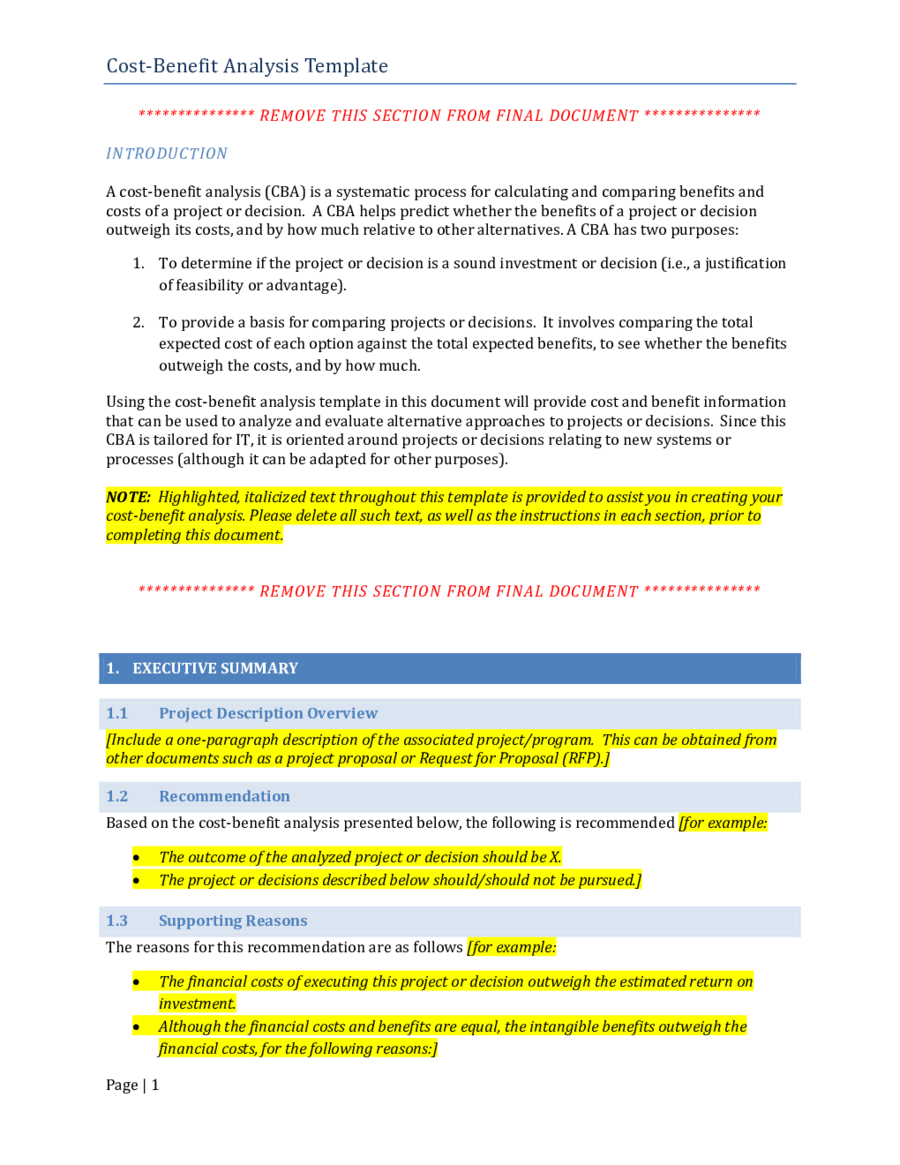Fillable Printable Cost Benefit Analysis Example
Fillable Printable Cost Benefit Analysis Example

Cost Benefit Analysis Example

Cost-Benefit Analysis Template
Page | 1
*************** REMOVE THIS SECTION FROM FINAL DOCUMENT ***************
INTRODUCTION
A cost-benefit analysis (CBA) is a systematic process for calculating and comparing benefits and
costs of a project or decision. A CBA helps predict whether the benefits of a project or decision
outweigh its costs, and by how much relative to other alternatives. A CBA has two purposes:
1. To determine if the project or decision is a sound investment or decision (i.e., a justification
of feasibility or advantage).
2. To provide a basis for comparing projects or decisions. It involves comparing the total
expected cost of each option against the total expected benefits, to see whether the benefits
outweigh the costs, and by how much.
Using the cost-benefit analysis template in this document will provide cost and benefit information
that can be used to analyze and evaluate alternative approaches to projects or decisions. Since this
CBA is tailored for IT, it is oriented around projects or decisions relating to new systems or
processes (although it can be adapted for other purposes).
NOTE: Highlighted, italicized text throughout this template is provided to assist you in creating your
cost-benefit analysis. Please delete all such text, as well as the instructions in each section, prior to
completing this document.
*************** REMOVE THIS SECTION FROM FINAL DOCUMENT ***************
1. EXECUTIVE SUMMARY
1.1 Project Description Overview
[Include a one-paragraph description of the associated project/program. This can be obtained from
other documents such as a project proposal or Request for Proposal (RFP).]
1.2 Recommendation
Based on the cost-benefit analysis presented below, the following is recommended [for example:
The outcome of the analyzed project or decision should be X.
The project or decisions described below should/should not be pursued.]
1.3 Supporting Reasons
The reasons for this recommendation are as follows [for example:
The financial costs of executing this project or decision outweigh the estimated return on
investment.
Although the financial costs and benefits are equal, the intangible benefits outweigh the
financial costs, for the following reasons:]

Cost-Benefit Analysis Template
Page | 2
2. GENERAL INFORMATION
2.1 Purpose
The purpose of this cost-benefit analysis is to determine whether [decision or project name] is the
best option for [organization name] to pursue at this time.
2.2 Overview
The following is a brief overview of the [decision or project] analyzed in this document.
Responsible organization: [Organization name]
Project title or decision question: [Project name or decision question]
Project ID number: [if any]
Description: [A short description of the project or decision]
[If dealing with software or hardware] Operational status
o In operation
o Under development
o Undergoing a major modification/upgrade
3. DESCRIPTION OF ALTERNATIVES CONSIDERED
[This section identifies the alternative approaches for the project or decision (for example, as
determined in a feasibility study or scan of a particular market for products or services) and provides
a brief description of each. In addition, it provides a description of the current situation, if relevant.
This information can be drawn from existing documents, such as As-Is and To-Be process flows or
websites and wikis that describe the current system or process.]
4. COSTS (Tab 2 of Excel workbook)
[This section provides all costs to develop and operate each alternative described above, including
both one-time and recurring costs. A template for calculating these costs is provided in the companion
Excel workbook. This spreadsheet may be used or costs and benefits may be presented by listing them
below for each alternative.
Examples of types of costs include:
Development costs
Operational costs
Non-recurring costs such as capital investment costs
Recurring costs such as leases, utilities and other overhead]

Cost-Benefit Analysis Template
Page | 3
5. BENEFITS (Tab 3 of Excel workbook)
[This section describes benefits that can be assigned dollar values for each alternative system
described above. Like costs, this may be done in the companion spreadsheet or by listing out the
specific category of benefits for each alternative below
Examples of types of benefits include:
Cost reductions such as value enhancement
Recurring benefits, such as lower overhead
Labor cost reductions]
6. COMPARATIVE COST/BENEFIT SUMMARY (tab 4 of Excel workbook)
[This is a summary of the cost and benefits identified in detail in the previous sections. Present the
elements below in a manner that facilitates comparison.
As with sections 4 and 5, this may be done in the companion spreadsheet or by listing out the specific
category of benefits for each alternative under the appropriate section headings. This section should
include:
Cost of each alternative over its estimated lifetime (taken from section 4)
Expected benefits of each alternative over its estimated lifetime (taken from section 5)
Comparison of the two
Recommendation based on the comparison
Additional reasons for the recommendation, if any]



